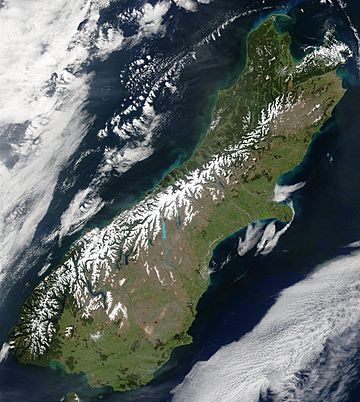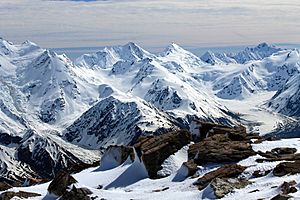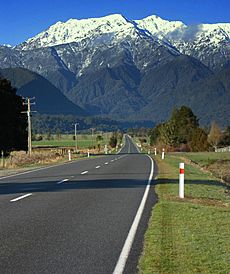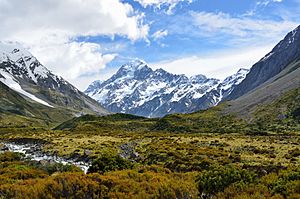Southern Alps facts for kids
Quick facts for kids Southern Alps / Kā Tiritiri o te Moana |
|
|---|---|

Snow highlights the mountain range in this satellite image
|
|
| Highest point | |
| Peak | Aoraki / Mount Cook |
| Elevation | 3,724 m (12,218 ft) |
| Dimensions | |
| Length | 500 km (310 mi) |
| Geography | |
| Location | South Island, New Zealand |
| Range coordinates | 43°30′S 170°30′E / 43.500°S 170.500°E |
The Southern Alps are a long mountain range in New Zealand. They stretch across most of the South Island. Their highest points are found on the western side. The official name is Southern Alps / Kā Tiritiri o te Moana.
This mountain range includes the Main Divide of the South Island. This divide separates the areas where water collects on the eastern side from those on the west coast. It also marks the border between different regions. These include Marlborough, Canterbury, and Otago to the southeast. On the northwest side are the Tasman and West Coast regions.
Contents
- What's in a Name? Discovering the Southern Alps' History
- Exploring the Geography of the Southern Alps
- How the Mountains Formed: Geology of the Southern Alps
- Plants of the Mountains: Flora of the Southern Alps
- Animals of the Mountains: Fauna of the Southern Alps
- Protecting the Mountains: Threats and Preservation
- Panoramic View
- See also
What's in a Name? Discovering the Southern Alps' History
The Māori name for the range is Kā Tiritiri o te Moana. This beautiful name means "the Mirage of the Ocean."
An English explorer named James Cook gave the mountains their English name. He called them the Southern Alps on March 23, 1770. He was very impressed by their "prodigious height," which means their amazing height. Before Cook, Abel Tasman saw them in 1642. He described the South Island's west coast as "a land uplifted high."
The official name was updated in 1998. It became Southern Alps / Kā Tiritiri o te Moana. This change happened after the Ngāi Tahu Claims Settlement Act 1998 was passed.
Exploring the Geography of the Southern Alps
The Southern Alps stretch for about 500 kilometers (310 miles). They run from the northeast to the southwest. The tallest peak is Aoraki / Mount Cook. It is the highest point in New Zealand, standing at 3,724 meters (12,218 feet) tall.
The Southern Alps have sixteen other peaks that are over 3,000 meters (9,800 feet) high. You can find many glaciers here. In the late 1970s, there were over 3,000 glaciers larger than one hectare. The longest one is the Tasman Glacier. It is 23.5 kilometers (14.6 miles) long.
The mountains are cut by valleys formed by glaciers. Many of these valleys have glacial lakes on the eastern side. Examples include Lake Coleridge in the north and Lake Wakatipu in Otago in the south.
Towns and Passes: Getting Around the Mountains
Some small towns are found in the Southern Alps. These include Maruia Springs, which has a spa near Lewis Pass. There is also the town of Arthur's Pass and Mount Cook Village.
Several main roads cross the Southern Alps. These mountain passes help people travel through the range. Key crossings include Lewis Pass (State Highway 7), Arthur's Pass (State Highway 73), and Haast Pass (State Highway 6). There is also a road to Milford Sound (State Highway 94).
Mountain Weather: Climate of the Southern Alps
New Zealand has a humid, mild climate. The Southern Alps stand right in the path of the strong westerly winds. The amount of rain and snow changes a lot across the range. The West Coast gets about 3,000 mm (118 inches) of rain each year. Near the Main Divide, it can get up to 15,000 mm (590 inches). About 30 km (19 miles) east of the divide, it drops to 1,000 mm (39 inches).
This heavy rainfall helps glaciers grow above the Snow line. Large glaciers and snowfields are mostly found on the west side or on the Main Divide. Smaller glaciers are further east.
The mountains are great for glider pilots. The town of Omarama is known worldwide for its gliding conditions. The westerly winds also create a special cloud pattern. It's called the Nor'west arch. This looks like an arch of cloud in an otherwise blue sky. It's often seen in summer over Canterbury and North Otago.
How the Mountains Formed: Geology of the Southern Alps
The Southern Alps sit on a plate boundary. This is where two huge pieces of the Earth's crust meet. The Pacific Plate is pushing west. It crashes into the Indo-Australian Plate, which is moving north. This collision has been happening for 45 million years. It has pushed up a huge amount of rock to form the Alps.
The mountains are still growing today due to this pressure. This causes earthquakes along the Alpine Fault and other nearby faults. Scientists have also found "extreme" hot water activity under a town called Whataroa. This could be very important for energy in the future.
Plants of the Mountains: Flora of the Southern Alps
The mountains are full of different plants. About 25% of New Zealand's plant species live above the treeline. This area has alpine plant habitats and grasslands. Lower down, on the eastern side, there are mountain beech forests.
The cold, windy slopes above the treeline have areas of fellfield. This is where plants grow in rocky, exposed places. To the east, the Alps lead down to the Canterbury-Otago tussock grasslands. Plants that are good at living in the mountains include:
- Woody shrubs like Hebe, Dracophyllum, and Coprosma.
- The conifer snow totara (Podocarpus nivalis).
- Carex sedge grasses.
Animals of the Mountains: Fauna of the Southern Alps
The mountains are home to many unique animals. One special bird is the rock wren (Xenicus gilviventris). This bird is found only in New Zealand. There are also many insects that live only in these high places. These include flies, moths, beetles, bees, and the mountain stone wētā. The wētā can even freeze solid in winter and still survive!
The beech forests at lower heights are important homes for several birds:
- The great spotted kiwi (Apteryx haastii).
- The South Island kākā (Nestor meridionalis meridionalis).
- The orange-fronted kākāriki (Cyanoramphus malherbi).
The Kea is a very special bird. It lives in the forested foothills and also in the colder, higher parts of the mountains. It is the only alpine parrot in the world!
Protecting the Mountains: Threats and Preservation
Most of the Southern Alps are hard to reach. This means their natural plants and animals are well preserved. A large part of the range is protected by national parks. These include:
- Westland Tai Poutini National Park
- Mount Aspiring National Park
- Aoraki / Mount Cook National Park
Other areas are also protected, like Lake Sumner Forest Park. However, some introduced animals can harm the native plants. These include red deer (Cervus elaphus), chamois (Rupicapra rupicapra), and Himalayan tahr (Hemitragus jemlahicus). Sometimes, these animals are hunted to control their numbers. Native birds and reptiles are also in danger from introduced predators.
Panoramic View
See also
 In Spanish: Alpes del Sur para niños
In Spanish: Alpes del Sur para niños






